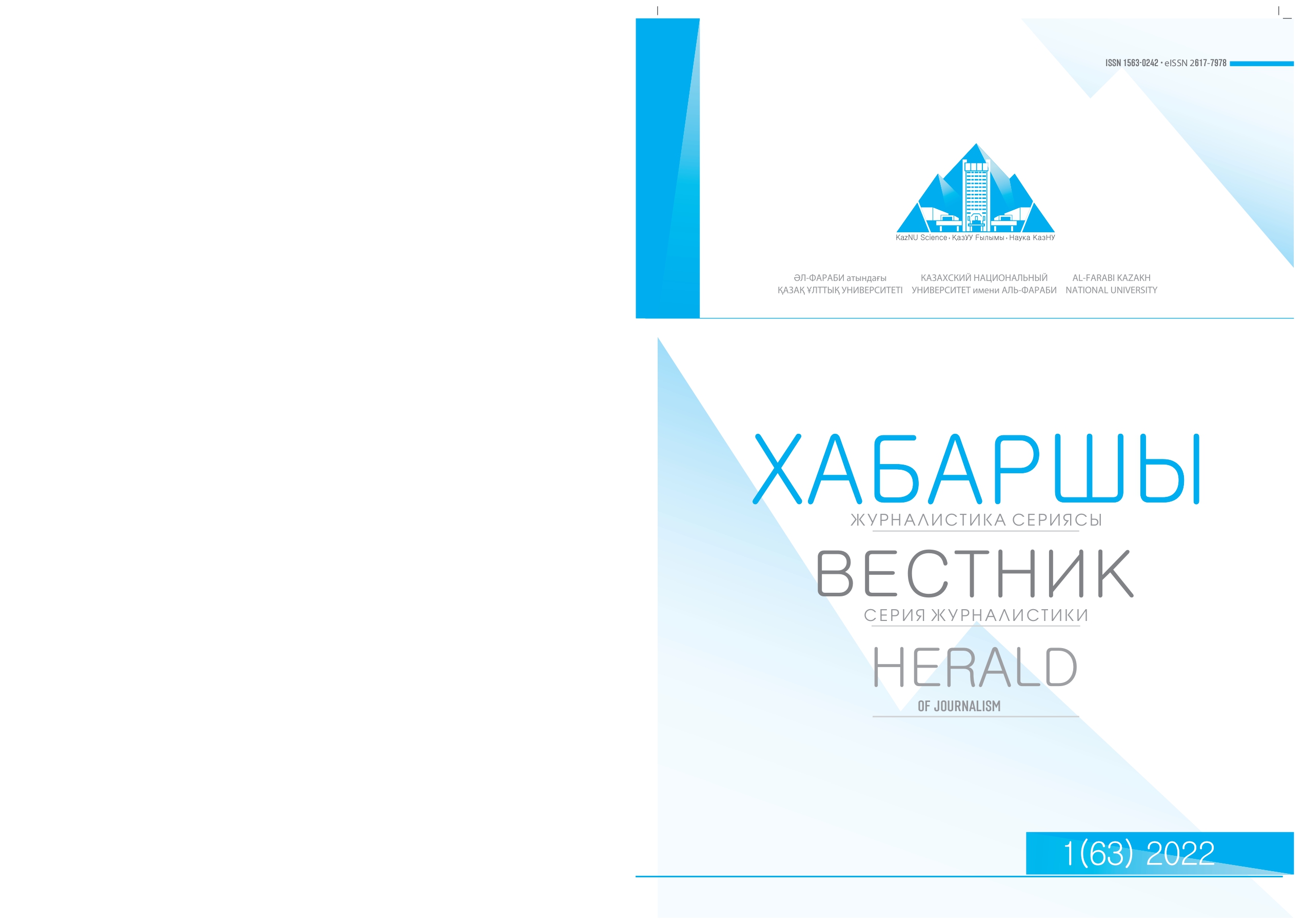Review of the literature on the topic of censorship and self-censorship in journalism in the context of freedom of speech
DOI:
https://doi.org/10.26577/HJ.2022.v63.i1.12Abstract
For the development of a democratic state, public understanding of freedom of speech is very important (Çarkoğlu & Andı, 2020). Journalism, which should provide impartial, objective and truthful information, is not always able to fully fulfill its role. It depends on various factors in the country and the society in which the media exists.
The main purpose of the study is to determine what studies have been conducted on the topic of censorship and self-censorship in the field of media and communication and what were their main ideas; the article also seeks answers to questions such as their current relevance and importance in the information production process. Since these terms are more studied in the western world than in the post-soviet countries, this paper focuses on the work of such researchers as O'Higgins, Sen, Cook and Heilman. Kazakhstani materials on freedom of speech will also be considered.
The scientific and practical significance of the work lies in the fact that the future specialist will be able to distinguish these terms from his student days in order to understand the impact of censorship and self-censorship on the formation of the media agenda and the implementation of journalistic activities.
According to the study, many researchers say, that censorship is pressure from the state, and self-censorship is a response to this pressure. According to Olga Zeveleva, censorship is activated when self-censorship does not work (Zeveleva, 2020). That is, censorship is described as the result of effective work. By studying the review of western literature written in recent years, future professionals will be able to apply this knowledge for further research, understanding of media theory and journalism.
Keywords: censorship, self-censorship, freedom of speech, agenda setting.
References
Abramov, D.(2010). Results of research “Kazakhstan mass media: key participants, possibilities, needs and risks”. The International Centre of Journalism MediaNet
Bodrunova, S. S., Litvinenko, A., & Nigmatullina, K. (2021). Who is the censor? Self-censorship of Russian journalists in professional routines and social networking. Journalism, 22(12), 2919–2937. https://doi.org/10.1177/1464884920941965
Çarkoğlu, A., & Andı, S. Support for Censorship of Online and Offline Media: The Partisan Divide in Turkey. The International Journal of Press/Politics, 194016122093532. https://doi.org/10.1177/1940161220935322
Çipuri, R. (2015). Reasons of self-censorship landscape for journalists. International research review, Thesis no 1.
Cook, P., & Heilmann, C. (2013). Two Types of Self-Censorship: Public and Private. Political Studies, 61(1), 178–196. https://doi.org/10.1111/j.1467-9248.2012.00957.x
Elbaz, Sagi & Magal, Tamir & Nets-Zehngut, Rafi & abutbul selinger, Guy. (2017). Self-Censorship of Narratives of Political Violence in the Media. 10.1007/978-3-319-63378-7_6.
Fedirko, T. (2020). Self-censorships in Ukraine: Distinguishing between the silences of television journalism. European Journal of Communication, 35(1), 12–28. https://doi.org/10.1177/0267323119897424
Freedman, E., & GRAHAM, N. A. (2011). Theoretical Foundations for Researching the Roles of the Press in Today’s Central Asia. In E. Freedman & R. Shafer (Eds.), After the Czars and Commissars: Journalism in Authoritarian Post-Soviet Central Asia (pp. 1–16). Michigan State University Press. http://www.jstor.org/stable/10.14321/j.ctt7ztd46.3
Jungblut, M., & Hoxha, A. (2017). Conceptualizing journalistic self-censorship in post-conflict societies: A qualitative perspective on the journalistic perception of news production in Serbia, Kosovo and Macedonia. Media, War & Conflict, 10(2), 222–238. https://doi.org/10.1177/1750635216673283
Internews(2019). Issledovaniye potrebitel'skoy mediasoobshchestva Kazakhstana, 46
Kenny, T., & Gross, P. (2008). Journalism in Central Asia: A Victim of Politics, Economics, and Widespread Self-censorship. The International Journal of Press/Politics, 13(4), 515–525. https://doi.org/10.1177/1940161208324644
Koshkenov, N.,& Utemissov, Z.(2021). Kazakhstan media challenges in the context of media and government relations in the Republic of Kazakhstan. Bulletin of L.N. Gumilyov Eurasian National University. Journalism Series, № 1(134). 10.32523/2616-7174-2021-134-1-37-51
Milton, J(1644). AREOPAGITICA (JEBB ED.) http://files.libertyfund.org/files/103/1224_Bk.pdf
Myssayeva, K. (2021). Journalism education during the Independence years of Kazakhstan. Herald Of Journalism, 62(4), 4-12. doi:10.26577/HJ.2021.v62.i4.01
Newth, M.(2010). The long history of censorship http://www.beaconforfreedom.org/liste.html?tid=415&art_id=475
Oxford Reference. (n.d.). Censorship. In Oxfordreference.com. https://www.oxfordreference.com/view/10.1093/oi/authority.20110803095558166
Sak, K., & Ryskeldinova, S. B.(2021). Freedom of speech as a key condition for democracy. Bulletin of L.N. Gumilyov Eurasian National University. Journalism Series, № 1(134). 10.32523/2616-7174-2021-134-1-27-36
Scheufle, D.A., & Moy, P. (2000). TWENTY-FIVE YEARS OF THE SPIRAL OF SILENCE: A CONCEPTUAL REVIEW AND EMPIRICAL OUTLOOK. International Journal of Public Opinion Research, 12, 3-28.
Schimpfossl, E., & Yablokov, I. (2014). Coercion or Conformism? Censorship and Self-Censorship among Russian Media Personalities and Reporters in the 2010s. Demokratizatsiya: The Journal of Post-Soviet Democratization, 22(2), 295-311.
Schultz, D. On Liberty. https://www.mtsu.edu/first-amendment/article/872/on-liberty
Sen, S. (2014). RIGHT TO FREE SPEECH AND CENSORSHIP: A JURISPRUDENTIAL ANALYSIS. Journal of the Indian Law Institute, 56(2), 175–201. http://www.jstor.org/stable/43953700
Shafer, R., & GRAHAM, N. A. (2011). Soviet Foundations of the Post-Independence Press in Central Asia. In R. Shafer & E. Freedman (Eds.), After the Czars and Commissars: Journalism in Authoritarian Post-Soviet Central Asia (pp. 19–32). Michigan State University Press. http://www.jstor.org/stable/10.14321/j.ctt7ztd46.4
Sun, T., & Zhao, Q. (2021). Delegated Censorship: The Dynamic, Layered, and Multistage Information Control Regime in China. Politics & Society. https://doi.org/10.1177/00323292211013181
Tai, Q. (2014). China’s Media Censorship: A Dynamic and Diversified Regime. Journal of East Asian Studies, 14(2), 185–209. http://www.jstor.org/stable/26335242
Yesil, M. & Mahallesi, Karaciğan & Caddesi, Ankara & Karatay, & Turkey, Konya. (2014). The Invisible Threat for the Future of Journalism: Self-Censorship and Conflicting Interests in an Increasingly Competitive Media Environment. 3.
Zeveleva Olga (2020). Self-censorship of journalists in Tatarstan and Crimea in a comparative perspective: Pierre Bourdieu and the new theory of censorship. Laboratory: Journal of Social Research. 12(3):150–177 DOI: 10.25285/2078-1938-2020-12-3-150-177
Электронды ресурстар
https://freedomhouse.org/country/kazakhstan/freedom-world/2020
https://www.azattyq.org/a/31187155.html
https://web.telegram.org/z/#-1203983871
https://vlast.kz/obsshestvo/31155-cto-ne-tak-s-goszakazom-v-smi.html
https://qamshy.kz/article/65098-manhghystau-oblysyna-9-vagon-arpa-dgetkizildi#




